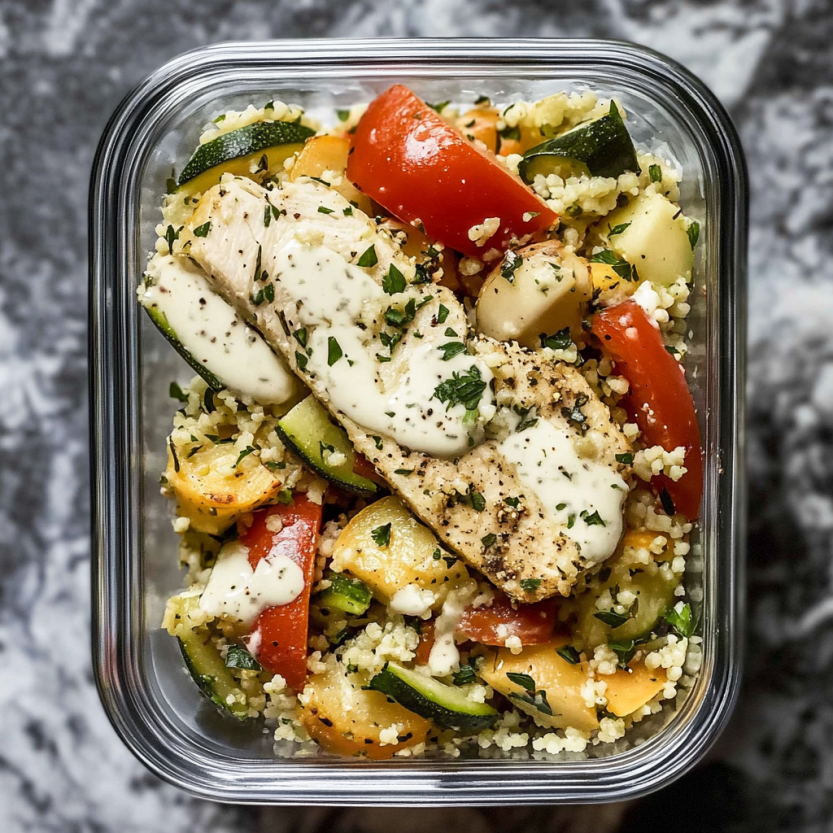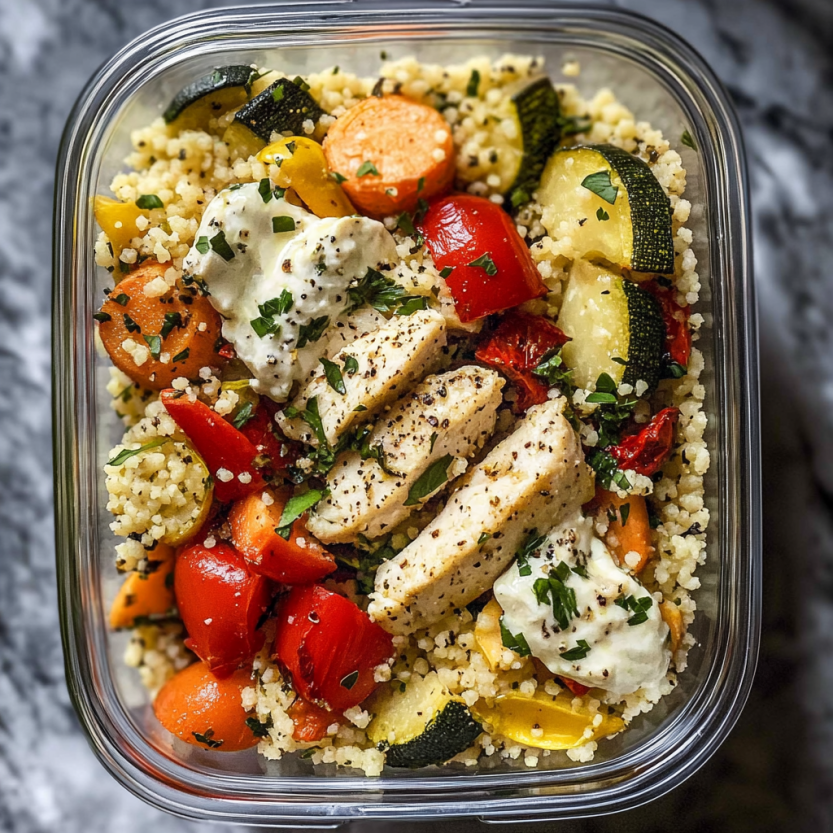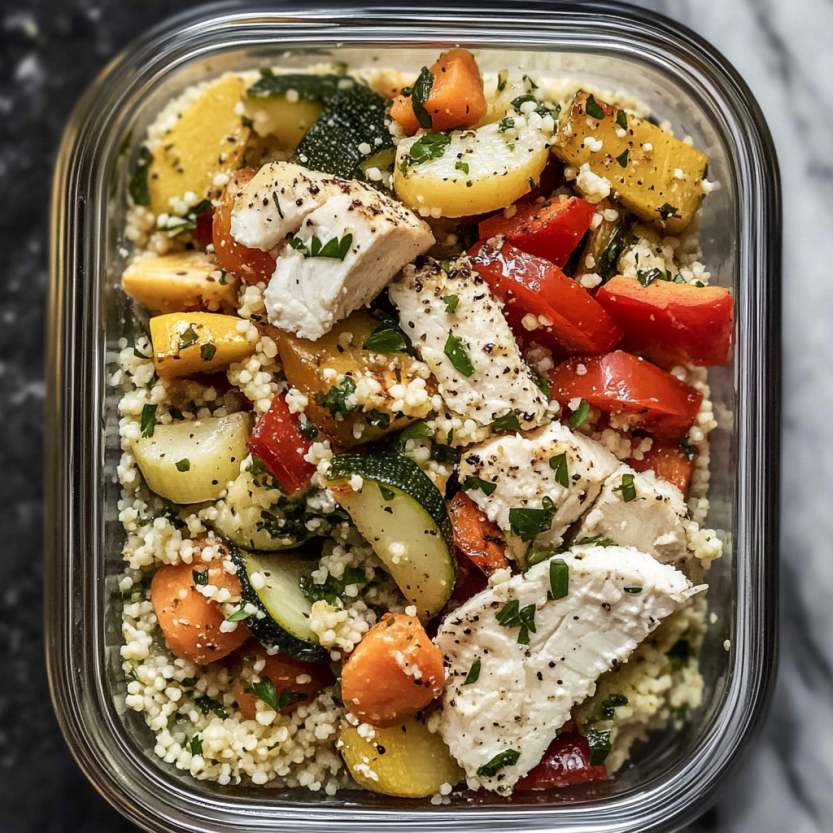 Save
Save
This roasted vegetable couscous meal prep has become my weeknight dinner solution for busy professionals who still want to eat healthy. The beauty of this recipe lies in its versatility—you can make it with tender chicken breast for extra protein or keep it vegetarian with garlic-herbed chickpeas.
I created this recipe during a particularly hectic work week when I needed lunches that wouldn't require daily cooking. Now it's become a Sunday tradition that ensures I eat well all week long, even on my busiest days.
Ingredients
- Zucchini: adds moisture and subtle sweetness choose firm ones with unblemished skin
- Roma tomatoes: concentrate in flavor when roasted pick ones that feel heavy for their size
- Bell pepper: provides sweet crunch and vitamin C use any color you prefer
- Red onion: offers aromatic depth and turns slightly sweet when caramelized
- Couscous: cooks in just 5 minutes and absorbs all the roasted vegetable flavors
- Fresh parsley: brightens the entire dish and adds color use Italian flat-leaf for best flavor
- Chicken breasts or chickpeas: flexible protein options depending on dietary preference
- Herb butter: transforms ordinary chicken into something extraordinary with minimal effort
Step-by-Step Instructions
- Roast the Vegetables:
- Chop vegetables into uniform pieces about 1 inch in size to ensure even cooking. The magic happens at 400°F when the natural sugars caramelize and concentrate, creating deep flavors that make this dish special. Stirring every 15 minutes prevents burning and promotes even browning.
- Prepare the Couscous:
- Pour boiling broth over couscous and let stand covered for exactly 5 minutes. The tiny pasta pearls absorb the liquid and steam to perfection without any stirring needed. Fluffing with a fork separates the grains and prevents clumping. Chilling it slightly helps maintain texture when mixed with hot vegetables.
- Season the Protein:
- Whether using chicken or chickpeas, the same herb blend creates cohesive flavor throughout the dish. For chicken, the room temperature butter helps herbs adhere and keeps meat moist during baking. For chickpeas, sautéing first creates textural contrast before adding seasonings.
- Combine Components:
- Mincing the roasted garlic cloves is crucial as they transform into a mellow paste that distributes evenly throughout. Toss everything while components are still slightly warm to help flavors meld without making the couscous soggy. The parsley should be added last to maintain its bright color and flavor.
 Save
Save
The first time I made this recipe, I accidentally overcooked the chickpeas until they were super crispy. What seemed like a mistake turned into a happy accident—the textural contrast between crispy chickpeas and soft couscous was absolutely delightful. Now I intentionally cook some chickpeas longer for that extra crunch.
Storage Secrets
This meal prep stays remarkably fresh in airtight containers for up to four days in the refrigerator. The flavors actually improve after a day as everything melds together. For the best texture, store the optional ranch dressing separately and add it just before eating. If you're making this for the entire week, consider freezing two portions—couscous freezes beautifully and reheats with minimal texture change when thawed overnight in the refrigerator.
Customization Options
This recipe serves as a perfect template for endless variations. Swap seasonal vegetables based on what looks fresh—butternut squash and brussels sprouts work wonderfully in fall, while asparagus and peas shine in spring. The herb profile can shift to match your preferences—try za'atar for Middle Eastern flair or herbes de Provence for a French twist. For a gluten-free version, quinoa makes an excellent substitute for couscous with similar cooking methods.
Nutritional Powerhouse
Beyond just being convenient, this meal provides exceptional nutritional balance. The colorful vegetable medley delivers a spectrum of vitamins and antioxidants. The protein from either chicken or chickpeas helps maintain muscle and provides satiety. The complex carbohydrates in couscous offer sustained energy without blood sugar spikes. For those watching sodium, you can reduce the salt in the seasonings and use low-sodium broth without sacrificing flavor.
 Save
Save
Recipe Questions
- → Can I substitute other vegetables in this dish?
Absolutely! While the recipe calls for Roma tomatoes, zucchini, bell pepper, and red onion, you can easily substitute with seasonal vegetables like eggplant, mushrooms, butternut squash, or carrots. Just ensure they're cut to similar sizes for even roasting.
- → How long will these meal prep containers stay fresh?
When stored properly in airtight containers in the refrigerator, these meals will stay fresh for 4-5 days. For best quality, store the optional ranch dressing separately and add just before eating.
- → Can I use other grains instead of couscous?
Yes, quinoa, bulgur wheat, or even brown rice would work well as substitutes for couscous. Just adjust the cooking liquid and time according to package directions for your chosen grain.
- → Is this dish freezer-friendly?
While it can be frozen, the texture of the vegetables and couscous may change slightly upon thawing. For best results, freeze without the dressing and consume within 2-3 months. Thaw overnight in the refrigerator before reheating.
- → How should I reheat this meal prep?
For best results, reheat in a microwave for 2-3 minutes, stirring halfway through. If you prefer using an oven, transfer to an oven-safe dish, cover with foil, and heat at 350°F for about 15 minutes or until heated through.
- → Can I make this dish spicy?
Definitely! Add red pepper flakes to the vegetable mix before roasting, include a diced jalapeño, or mix some hot sauce with the ranch dressing for a spicy kick.